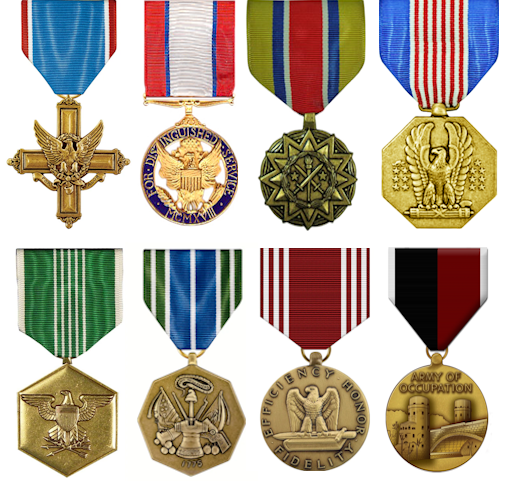The United States Army awards medals and service ribbons for a variety of accomplishments.
Often, this involves some type of valorous act that falls outside the traditional or normal expectations of service.
Therefore, U.S. Army medals are very significant and represent some of the highest honors of military service.
Learn more about 8 Army Medals Ranked In Order, below.
Related Article – Air Force Medals Ranked In Order
Table of Contents
Army Medals Ranked In Order
The United States Army seeks to recognize soldiers for heroic and courageous acts of service.
Accordingly, the Army has established a variety of service medals for soldiers.
These include important and prestigious awards such as the Army Distinguished Service Cross and Soldier’s Medal.
U.S. Army medals are ranked in order of precedence on the formal military uniform.
The ranking is determined in the following order:
- Army Distinguished Service Cross
- Army Distinguished Service Medal
- Soldier’s Medal
- Army Commendation Medal
- Army Achievement Medal
- Good Conduct Medal
- Army Reserve Components Achievement Medal
- Army Occupation Medal
Learn more about each Army award and medal, below:
#1. Army Distinguished Service Cross
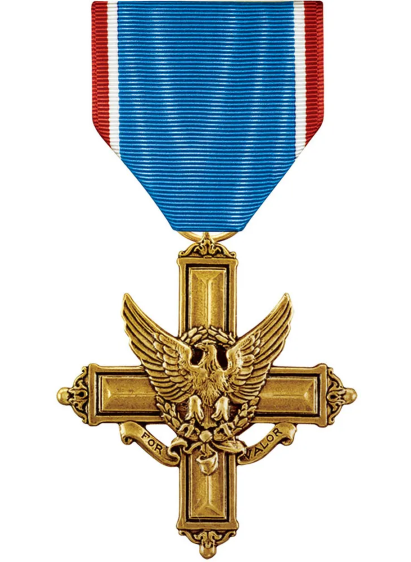
The Army Distinguished Service Cross (DSC) is the second highest military decoration soldiers can earn after the Medal of Honor.
It’s designed to recognize those who display extraordinary heroism in combat with an armed enemy force.
In general, the courageous act of heroism must have been so notable that it involved extraordinary risk of life.
Therefore, in order of precedence, the Army Distinguished Service Cross ranks above all other U.S. combat decorations, except for the Medal of Honor.
The Army Distinguished Service Cross is the equivalent of the Navy Cross and Coast Guard Cross.
Furthermore, the United States Air and Space Forces also have their own variation of the military award.
Previously, members of the Air Force were also eligible for the Army variant.
History
The Army Distinguished Service Cross has a long and important history in the Armed Forces.
In fact, the Distinguished Service Cross has origins from World War I.
While more soldiers earned the Distinguished Service Cross in WWI compared to any other conflict, it continues to be awarded in the present day.
The Army Distinguished Service Cross includes several famous and notable award recipients, including George S. Patton and Carl Spaatz.
There have also been recipients from the Korean War and Vietnam War, along with the more recent invasions of Iraq and Afghanistan.
Furthermore, the Distinguished Service Cross has been presented recently to Master Sergeant David R. Halbruner for his actions during the 2012 Benghazi attack.
Often, the Army Distinguished Service Cross is confused with the Distinguished Service Medal (see, below).
Whereas the Distinguished Service Cross is only presented for actions in combat, the Distinguished Service Medal has no such restriction.
Appearance
The Army medal is composed of a bronze cross with an eagle in the center along with a scroll.
The scroll reads “For Valor” while the reverse side contains a wreath with a space reserved for the name of the recipient.
Finally, the Army Distinguished Service Cross features an accompanying service ribbon (like most Army awards).
#2. Army Distinguished Service Medal
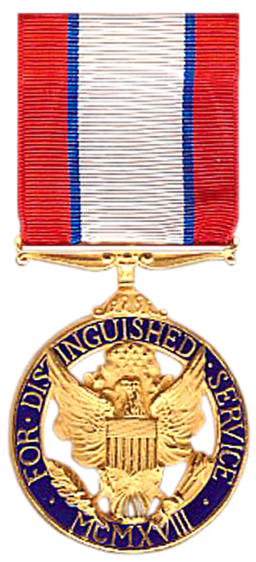
The Distinguished Service Medal (DSM) is frequently confused with the Army Distinguished Service Cross.
Generally, the Distinguished Service Medal is awarded to soldiers who, while serving in the U.S. Army, distinguished themselves with exceptionally meritorious service.
More often, this involves some duty of great responsibility, which is why the military award is usually only offered to higher-ranking members of the Army.
Additionally, emphasis is often placed on the term “exceptional service.”
Thus, exceptional performance of ordinary or general duties is usually not sufficient to earn this military decoration.
The Distinguished Service Medal is the equivalent of the same medal that is presented to members of the U.S. Navy, Coast Guard, and Air & Space Forces.
In the past, those serving in the United States Air Force were eligible for the Army variant.
Today, the military honor is only offered to members of the Armed Forces only for wartime services, and only then under “exceptional” circumstances.
The Army Distinguished Service Medal is known for its appearance, which features a stylish dark blue and bronze design.
The inscription “For Distinguished Service MCMXVIII” follows the dark blue circle with the name of the recipient displayed on the backside.
Meanwhile, additional awards of the Distinguished Service Medal are denoted by oak leaf clusters.
Lastly, it’s worth mentioning that the Distinguished Service Medal has a history that also dates back to WWI.
The military award was officially established by a Presidential Order in 1918.
Related Article – 10 Marine Corps Medals Explained
#3. Army Soldier’s Medal
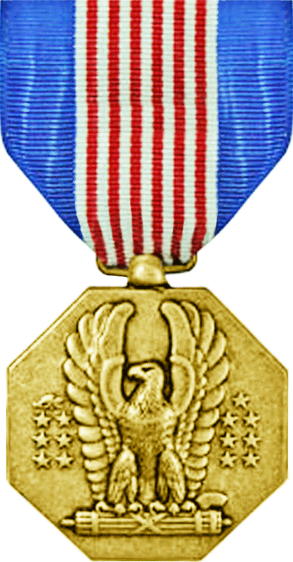
The Army Soldier’s Medal (SM) is another noteworthy military decoration.
The award was established in 1926 and usually represents the equivalent of the Navy and Marine Corps Medal.
Moreover, the Air and Space Forces also have a comparable award with the Airman’s Medal.
Then, there is also the Coast Guard Medal to consider in regard to an equivalent in that service branch.
In general, the criteria for the Army Soldier’s Medal distinguish themselves by heroism not involving conflict with an enemy.
Thus, eligibility is open to any person of the U.S. Armed Forces along with members of a friendly foreign nation.
The Army restricts eligible conduct to an action involving personal hazard or danger, along with the voluntary risk of life.
However, awards are not purely offered on the basis of having saved a life.
In the past, the Army Soldier’s Medal was presented the most during World War II.
Additionally, members of the U.S. Air Force were previously eligible for the military honor before creating their own version of the award.
Today, the Army Soldier’s Medal ranks as the second-highest non-combat award in the military branch.
What’s more, the award also comes with a substantial pay increase in retirement benefits, which is also much appreciated by soldiers.
The appearance of the Army Soldier’s Medal is based on a bronze octagon design featuring an American eagle.
Then, on the reverse side of the Army medal is the inscription “U.S. Soldier’s Medal” and “For Valor”, along with the name of the recipient.
There are several notable past recipients of the Army Soldier’s Medal, including Colin Powell.
Lastly, additional awards of the medal are denoted by oak leaf clusters, like the other Army medals on the list.
#4. Army Commendation Medal
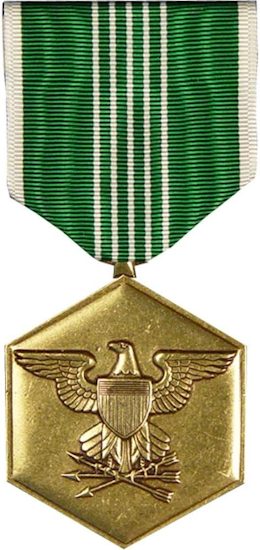
The United States Army also issues the Commendation Medal, which is presented in every service branch of the Armed Forces.
Additionally, there is a 5th version reserved for joint service performed and authorized by the Department of Defense (DoD).
The Commendation Medal is considered a mid-level military decoration for sustained acts of heroism or meritorious service.
It was originally only a service ribbon before many branches began to also include a medallion with the award.
The United States Navy and Coast Guard were the first branches to establish a version of the award in 1943.
However, it didn’t take the U.S. Army longer than a couple of years to follow with its own version in 1945.
Today, the Army variant authorizes the use of a combat “C” device or valorous “V” device.
These devices hang from the suspension ribbon and represent even more distinctions.
Then, there are also the bronze and silver oak leaf clusters which equate to subsequent awards.
In the past, the Army Commendation Medal has been awarded for acts of heroism, meritorious achievement, or meritorious service.
The eligible recipients of the Commendation Medal include Army ranks of O-6 (Colonel) or lower.
In general, the type of conduct involves no voluntary risk of life or sustained meritorious performance of duty.
Thus, approval for the award is usually determined by an Army officer of the grade above O-6.
The appearance of the medallion features a bronze hexagonal design.
It depicts an American bald eagle with its wings spread horizontally gasping its talons with 3 arrows.
Meanwhile, the reverse side is reserved for the name of the recipient, just like many other Army medals.
#5. Army Achievement Medal
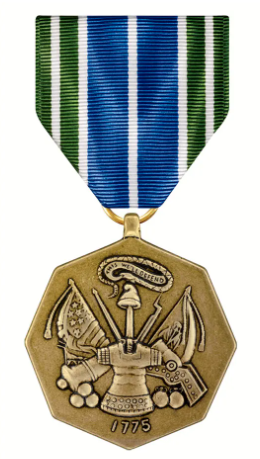
In general, the Army Achievement Medal (AAM) is offered to soldiers who don’t quite fit the criteria for the Commendation Medal.
Nonetheless, it remains an important military achievement deserving of a medal and service ribbon.
The Army Achievement Medal is usually granted to soldiers for outstanding achievement or meritorious service.
In the past, the Achievement Medal has not been awarded to service members above the pay grade of O-4.
Thus, the Achievement Medal is typically reserved for enlisted personnel along with junior Army officers.
Additionally, the Army Achievement Medal has been offered in a combat area yet for conduct that is not directly involved in combat.
For this reason, the Army Achievement Medal has been awarded much more frequently since the operations in Afghanistan and Iraq.
Often, commanding officers of the Army are granted broad authority and discretion to determine eligibility for the award.
The Achievement Medal is similar to the Commendation Medal in that both awards are offered in every branch of the Armed Forces.
Moreover, a 5th version is authorized by the Department of Defense for joint military activity.
The U.S. Army established its version of the military honor in 1981, a year after the U.S. Air Force version was established in 1980.
You’ll find additional awards on the military uniform represented by oak leaf clusters.
The silver oak leaf cluster represents 5 awards, whereas the silver star only represents a single additional honor.
#6. Army Good Conduct Medal
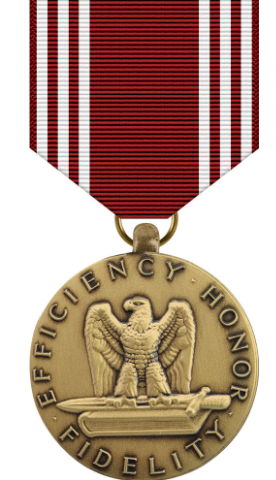
The Army Good Conduct Medal is a benchmark for many aspiring soldiers.
It recognizes members of the service branch who display 3 consecutive years of good conduct.
Therefore, soldiers can earn multiple distinctions depending on the length of their military career.
In general, eligibility guidelines state that “good conduct” signifies exemplary behavior, efficiency, and fidelity in active duty service.
Furthermore, soldiers who face disciplinary infractions or court-martial offenses have the ability to restore their reputation.
Accordingly, the 3 years of “good service” may reset at any time allowing soldiers to correct their behavior and earn the medal in the future.
In the past, the Army has reduced the length requirement from 3 years to 1 year during times of war.
Additionally, the Army Good Conduct Medal has been awarded posthumously just like many other military awards.
The Army Good Conduct Medal is also presented to members of the Reserve component that meet the same criteria (more details, below).
It’s worth mentioning that the Good Conduct Medal is one of the oldest military distinctions.
In fact, the origins of the Good Conduct Medal date back to the mid-19th century.
However, the Army version of the award did not actually arrive until 1941 (established during WWII).
Notwithstanding, the Good Conduct Medal remains one of the most recognizable Army medals.
The military award was featured on the hit TV show M*A*S*H and the loops in the ribbon were referred to as “Dentyne wrappers” during the Vietnam War.
Related Article – Good Conduct Medal & Ribbon Explained For All 5 Branches
#7. Army Reserve Components Achievement Medal
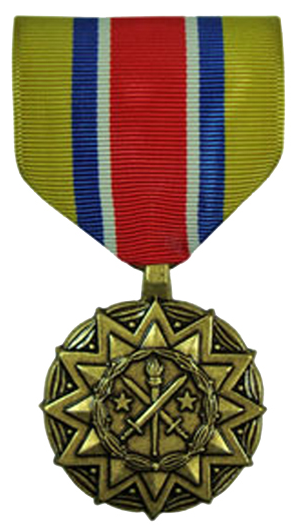
The Army Reserve Components Achievement Medal (ARCAM) is the equivalent of the aforementioned Good Conduct Medal.
The only primary difference is that ARCAM is reserved for the Reserve components of the military branch.
Still, those in the reserve components do not have to necessarily earn the time consecutively.
In fact, Army reservists can earn the honor through their duties such as drills and annual training.
For example, members of the Army National Guard and Air National Guard have earned the distinction in support roles following natural disasters.
In the past, the Army Reserve Components Achievement Medal required 4 years of honorable service.
However, in 1995, the time requirement was reduced to 3 years to reflect the same guidelines of the Army Good Conduct Medal.
Be that as it may, the change in guidelines was not retroactive, which means the 4-year requirement remains for those who served prior to the 1990s.
Additionally, just like the Good Conduct Medal, Army reservists who are disciplined also have the opportunity to correct their behavior.
Thus, the time “resets” whenever the behavior is restored and returns to an acceptable standard.
The Army Reserve Components Achievement Medal was established in 1971.
Today, the military decoration is presented to both officers and enlisted members of the Army Reserve and Army National Guard.
The award shouldn’t be confused with the Armed Forces Reserve Medal (AFRM), which was created in 1950, and presented for 10 years of honorable service.
#8. Army Of Occupation Medal
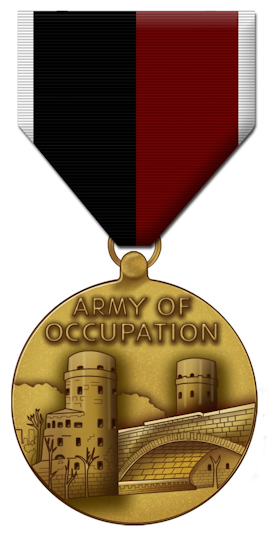
The Army of Occupation Medal was established following the aftermath of World War II.
For this reason, it also has a long and decorated history that dates back to 1946.
The military award was intended to recognize those who served in theaters in Germany, Italy, Austria, Japan, and Korea.
Moreover, the original Army of Occupation Medal was developed strictly for those in the service branch.
However, it wasn’t long before the U.S. Army also started to include those in the Air Force, like many other awards on the list.
Additionally, there are also equivalents of the award in both the branches of the U.S. Navy and Marine Corps.
The first recipient of the Army of Occupation Medal was General Dwight D. Eisenhower, who later became the 34th President of the United States (1953 – 1961).
Furthermore, the Army of Occupation Medal was assigned to soldiers frequently during the peak of the Cold War.
There were many that served along the West Berlin wall along with other military campaigns.
In order to qualify as a recipient, a service member is required to perform 30+ consecutive days of military duty within a designated geographical area of military occupation.
In the past, the campaign clasp designated where the soldier had served (Europe or Pacific Theater).
Generally, the campaign clasps were worn with the Army medal with no corresponding device.
The appearance of the medal features references to both European and Asian campaigns, including Mount Fuji on the reverse side.
Related Article – 15 US Navy Ribbons Explained
Conclusion
There are many important Army medals in the service branch.
These include important distinctions such as the Soldier’s Medal and Distinguished Service Cross.
The order of precedence dictates the correct placement on the military uniform.
For this reason, it’s important to learn about the purpose and appearance of Army medals.
- Replacing Dog Tags: 6 Things You Need to Know - June 28, 2024
- Navy OAR Test Study Guide - June 24, 2024
- 10 Best Sniper Movies of all Time - June 20, 2024
Originally posted on June 23, 2023 @ 5:46 pm
Affiliate Disclosure: This post may contain affiliate links. If you click and purchase, I may receive a small commission at no extra cost to you. I only recommend products I have personally vetted. Learn more.
